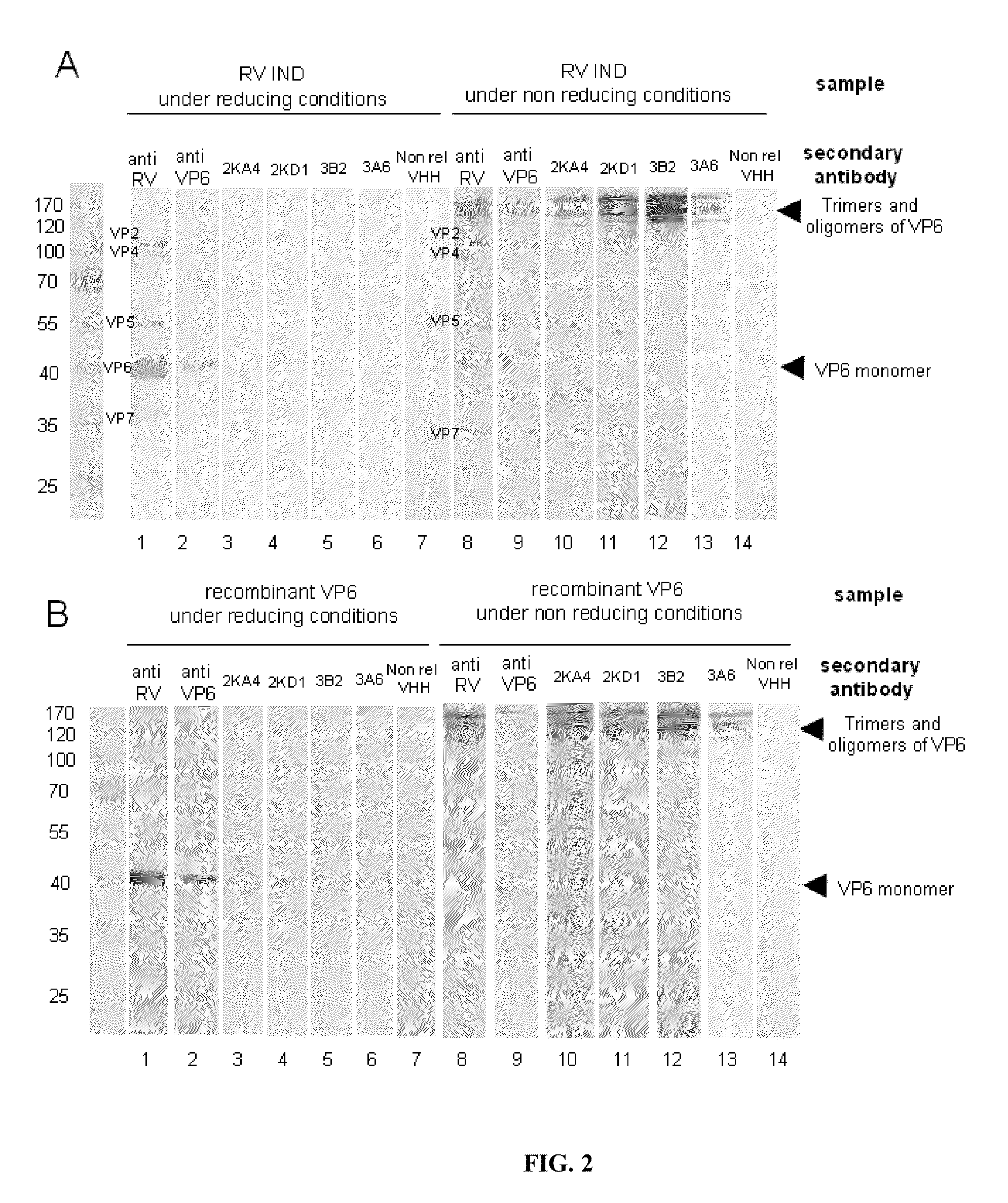Monomeric vhh domain derived from Anti-vp6 camelid antibodies, dimeric domain, immunisation method, rotavirus detection method, composition, prevention and treatment methods for rotavirus infections
a technology of antibody and vhh domain, which is applied in the field of monomeric vhh domain derived from anti-vp6 camelid antibodies, immunisation methods, composition, prevention and treatment methods of rotavirus infections, can solve the problems of high cost of prevention or treatment, inability to prevent rv infection, and low reproducibility of antibodies,
- Summary
- Abstract
- Description
- Claims
- Application Information
AI Technical Summary
Benefits of technology
Problems solved by technology
Method used
Image
Examples
example 1
Obtainment and Purification of the Monomeric and Dimeric VHH of the Invention
Obtainment of the VHH Library of the Invention:
[0093]The reference bovine IND RV strain was used (SbI; P[5]G6) as an antigen in the biopanning process to select the VHH. In order to have an RV panel that represents different subgroup reactivities with different combinations of G and P types from different animal species and from humans, the reference RV strains listed in Table 4 were included in the different assays performed to produce the VHH. The viruses were propagated in monkey kidney cells (MA-104). Also included was a faecal sample from a colostrum-deprived neonatal calf infected with the IND strain at the time of pre-innoculation and at the peak of virus spreading.
TABLE 5Reference rotavirus strains used in the differentprocedures performed during the production andcharacterisation of the VHH of the inventionRVSpeciesStrainof originSubgroupG-P typeProcedureC486BovineIP[1]G6Recombinant VP6 antigenused...
example 2
Characterisation of the VHH of the Invention
[0100]Western blot: VP6 concentrates expressed in a baculovirus system and BRV IND concentrates were re-suspended in a Laemmli sample buffer, boiled for 10 minutes. They were then run through a 12% SDS-PAGE column and transferred to an Immobilon P membrane (Millipore, Berdford, Mass.). The membrane was blocked for 45 min with PBS / Tween (0.05%), containing 10% skim milk, and each of the VHH (4 μg / ml) were incubated for 2 h at ambient temperature. The membrane was then washed with PBS / Tween (0.05%) and incubated overnight at 4° C. with the anti-pentahistidine antibody (1 / 500 dilution in PBS / Tween (0.05%) BSA (3%). Finally, they were incubated with HRP-conjugated goat anti-mouse IgG (1 / 5,000 dilution) (Amersham, Pharmacia, Biotech) for 40 min at ambient temperature. The assays were developed with ECL (Amersham Biosciences).
[0101]Sequencing of the VHH of the invention: In order to sequence the VHH, the “M13 forward” and “M13 reverse” oligonucl...
example 3
RV Immunodetection Assays Using the VHH of the Invention
[0102]Enzyme immunoassay (ELISA) and Western blot: The ELISA experiments were performed in Maxisorp 96-well plates (Nunc), by direct sensitisation with RV or by capture of RV or of recombinant VP6 with a polyclonal antibody produced in a gnotobiotic pig. As antigens for the negative control, pseudo-infected MA-104 cells and a non-related protein expressed in baculoviruses (protein E2 of the bovine diarrhoea virus) were used. PBS was used as a blank, and non-immunised guinea pig serum was used as a negative capture.
[0103]The presence of anti-RV antibodies in the llama serum was analysed as described in Parreno, V. C. et. al., Vet Immunol Immunopathol 100:7-24, 2004, and that of anti-VP6 antibodies was analysed with a protocol adapted from Fernandez et al. (Fernandez, F. M. et al., Vaccine 16:507-16, 1998). The llama IgG were detected using a peroxidase-labelled goat anti-llama IgG (H+L) (Bethyl, lab inc, Montgomery, Calif., USA)...
PUM
| Property | Measurement | Unit |
|---|---|---|
| weight | aaaaa | aaaaa |
| pH | aaaaa | aaaaa |
| concentration | aaaaa | aaaaa |
Abstract
Description
Claims
Application Information
 Login to View More
Login to View More - R&D
- Intellectual Property
- Life Sciences
- Materials
- Tech Scout
- Unparalleled Data Quality
- Higher Quality Content
- 60% Fewer Hallucinations
Browse by: Latest US Patents, China's latest patents, Technical Efficacy Thesaurus, Application Domain, Technology Topic, Popular Technical Reports.
© 2025 PatSnap. All rights reserved.Legal|Privacy policy|Modern Slavery Act Transparency Statement|Sitemap|About US| Contact US: help@patsnap.com



